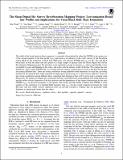Files in this item
The Sloan Digital Sky Survey Reverberation Mapping Project : low-ionization broad-line widths and implications for virial black hole mass estimation
Item metadata
| dc.contributor.author | Wang, Shu | |
| dc.contributor.author | Shen, Yue | |
| dc.contributor.author | Jiang, Linhua | |
| dc.contributor.author | Horne, Keith | |
| dc.contributor.author | Brandt, W. N. | |
| dc.contributor.author | Grier, C. J. | |
| dc.contributor.author | Ho, Luis C. | |
| dc.contributor.author | Homayouni, Yasaman | |
| dc.contributor.author | Li, Jennifer I-Hsiu | |
| dc.contributor.author | Schneider, Donald P. | |
| dc.contributor.author | Trump, Jonathan R. | |
| dc.date.accessioned | 2019-09-09T15:30:02Z | |
| dc.date.available | 2019-09-09T15:30:02Z | |
| dc.date.issued | 2019-09-01 | |
| dc.identifier | 261028405 | |
| dc.identifier | f427c567-3af1-4b13-9f4d-f60cef82cc64 | |
| dc.identifier | 85072310150 | |
| dc.identifier | 000483028900004 | |
| dc.identifier.citation | Wang , S , Shen , Y , Jiang , L , Horne , K , Brandt , W N , Grier , C J , Ho , L C , Homayouni , Y , Li , J I-H , Schneider , D P & Trump , J R 2019 , ' The Sloan Digital Sky Survey Reverberation Mapping Project : low-ionization broad-line widths and implications for virial black hole mass estimation ' , Astrophysical Journal , vol. 882 , no. 1 , 4 . https://doi.org/10.3847/1538-4357/ab322b | en |
| dc.identifier.issn | 0004-637X | |
| dc.identifier.other | ArXiv: http://arxiv.org/abs/1903.10015v2 | |
| dc.identifier.uri | https://hdl.handle.net/10023/18441 | |
| dc.description | Funding: UK STFC grant ST/R000824/1 (KH). | en |
| dc.description.abstract | The width of the broad emission lines in quasars is commonly characterized by either the FWHM or the square root of the second moment of the line profile (σ line) and used as an indicator of the virial velocity of the broad-line region (BLR) in the estimation of black hole (BH) mass. We measure FWHM and σ line for Hα, Hβ, and Mg ii broad lines in both the mean and rms spectra of a large sample of quasars from the Sloan Digital Sky Survey Reverberation Mapping project. We introduce a new quantitative recipe to measure σ line that is reproducible, is less susceptible to noise and blending in the wings, and scales with the intrinsic width of the line. We compare the four definitions of line width (FWHM and σ line in mean and rms spectra, respectively) for each of the three broad lines and among different lines. There are strong correlations among different width definitions for each line, providing justification for using the line width measured in single-epoch spectroscopy as a virial velocity indicator. There are also strong correlations among different lines, suggesting that alternative lines to Hβ can be used to estimate virial BH masses. We further investigate the correlations between virial BH masses using different line width definitions and the stellar velocity dispersion of the host galaxies and the dependence of line shape (characterized by the ratio FWHM/σ line) on physical properties of the quasar. Our results provide further evidence that FWHM is more sensitive to the orientation of a flattened BLR geometry than σ line, but the overall comparison between the virial BH mass and host stellar velocity dispersion does not provide conclusive evidence that one particular width definition is significantly better than the others. | |
| dc.format.extent | 14 | |
| dc.format.extent | 5174928 | |
| dc.language.iso | eng | |
| dc.relation.ispartof | Astrophysical Journal | en |
| dc.subject | Black hole physics | en |
| dc.subject | Galaxies: active | en |
| dc.subject | Line: profiles | en |
| dc.subject | Quasars: general | en |
| dc.subject | Surveys | en |
| dc.subject | QB Astronomy | en |
| dc.subject | QC Physics | en |
| dc.subject | DAS | en |
| dc.subject.lcc | QB | en |
| dc.subject.lcc | QC | en |
| dc.title | The Sloan Digital Sky Survey Reverberation Mapping Project : low-ionization broad-line widths and implications for virial black hole mass estimation | en |
| dc.type | Journal article | en |
| dc.contributor.sponsor | Science & Technology Facilities Council | en |
| dc.contributor.institution | University of St Andrews. School of Physics and Astronomy | en |
| dc.contributor.institution | University of St Andrews. St Andrews Centre for Exoplanet Science | en |
| dc.identifier.doi | 10.3847/1538-4357/ab322b | |
| dc.description.status | Peer reviewed | en |
| dc.identifier.grantnumber | ST/R00824/1 | en |
This item appears in the following Collection(s)
Items in the St Andrews Research Repository are protected by copyright, with all rights reserved, unless otherwise indicated.

